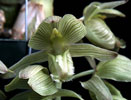|
|
|
|
 |
Email Address Recovery or Password Reset |
Use our Change Password page, and you can set a new password, or if you don't remember which email address you
registered with, the same page may be able to suggest it based on another you enter.
|
|
|
|
|
| |
Flasks of
Clowesia russelliana 'MC29' × self |
|
| |
|
|
| |
| Number: |
TN1134 |
| Name: |
Clowesia russelliana 'MC29' × self
|
| Type: |
self (What's that?) |
|
Seed Donor: |
Dale Borders
|
|
Click to Enlarge

Pod Parent Flower |
Click to Enlarge

Pod Parent Inflorescence |
Click to Enlarge

Pod Parent Capsules at 136 days |
|
|
|
| |
Culture Notes from Donor: Parent plant: Temperature range I (60-83°F)
For additional origin/habitat information supplied courtesy of
Charles and Margaret Baker, see further below, near the bottom of this page.
|
Temperatures we attempt to use in the lab & greenhouse:
| For Species: |
|
Spring, Summer, Autumn: days average 86°F, nights 70°F; best fit is Warm 90-70°F
(Source:
Baker's Web OSC) |
| For Species: |
|
Winter: days average 83°F, nights 64°F; best fit is Intermediate 83-60°F
(Source:
Baker's Web OSC) |
|
About the name...
| Etymology of |
Clowesia |
|
Named after Rev. J. Clowes, an English minister and orchid enthusiast, in the 1 half of the nineteenth century.
(Source:
Mayr & Schmucker 1998) |
| Pronunciation of |
Clowesia |
|
klo-WES-ee-ah
(Source:
Hawkes 1978) |
|
If you would like to direct someone to this web page, please copy and paste this URL into your email:
http://troymeyers.com/d?011134
| Flask Information |
| Availability: |
We have sold all of the flasks for this item. |
| You should: |
Consider getting individual plants or compots instead of a flask.
You can place a "Notify Flask Recipients" Request, and either we or a flask recipient may contact you when plants are available.
You may also place a "Notify Retries" Request, and if an identical pollination (the same parents) is done again, we'll let you know.
You may reserve a flask, but it's very unlikely you'll get one ...this could only happen if we found a flask that we didn't know we had. |
| Yield Estimate: |
184 plants (based on flask surveys done 08/06/2000 through 08/16/2002)
|
| Plantlet Sizes: |
From many flasks 10 - 20 mm plants (based on flask surveys done 08/16/2002 )
From one most recently surveyed flask 10 - 20 mm (08/16/2002)
|
|
You might also want to:
|
View the seed assay for this item.
View items of the same species.
View items of the same genus.
|
| Ordering Information |
| You are not currently logged in. |
|
You must be a registered user and be logged in to reserve a flask or place a notification request. Please log in:
|
|
 |
Email Address Recovery or Password Reset |
Use our Change Password page, and you can set a new password, or if you don't remember which email address you
registered with, the same page may be able to suggest it based on another you enter.
|
|
|
|
|
|
|
|
| |
The origin/habitat information below is supplied courtesy of Charles and Margaret Baker
The following information is based on the name of the plant provided by the donor, and assumes that the name is correct. If the plant has been misidentified, then the following information may not be correct.
This text is copyrighted by the Bakers and may not be reproduced without permission.
ORIGIN/HABITAT: Southern Mexico and Central America including Nicaragua.
Some writers report that the habitat extends into Costa Rica, Panama, and
Venezuela, but Dressler (1993) considers it unlikely that it will be found
in Costa Rica or Panama. It is rather rare, but it has been found in
numerous locations throughout its range. In Mexico, plants are found in
the States of Jalisco and Chiapas at up to 2300 ft. (700 m), but some
writers question whether or not the plants from Jalisco were actually
Clowesia russelliana. In McVaugh (1985), it is reported that Dodson
considers the range of this species to extend from Chiapas to Nicaragua.
In Belize, plants are found near Toledo at 200–300 ft. (60–90 m). In
Guatemala, plants grow near Patulúl on trees in open mountain forests near
1950 ft. (600 m). Plants are found in several locations in El Salvador at
350–3300 ft. (100–1000 m) and at numerous locations in Nicaragua, where
plants grow in fairly dry, open forests from near sea level to 0–2800 ft.
(0-850 m). In Venezuela, plants identified as Clowesia russelliana were
found in forests above El Limón and near Tiara at about 3950 ft. (1200 m).
More about this information and the Bakers...
|
|
|
| |
|
|
|